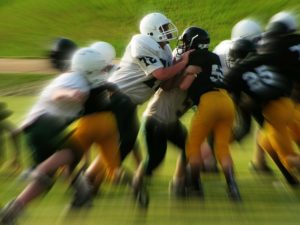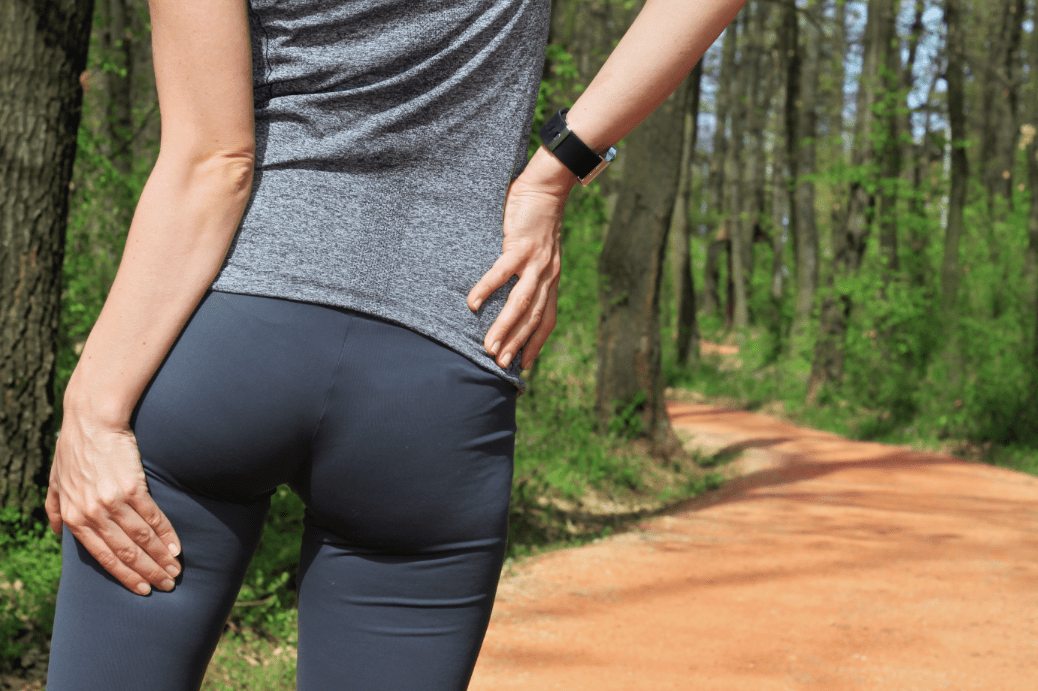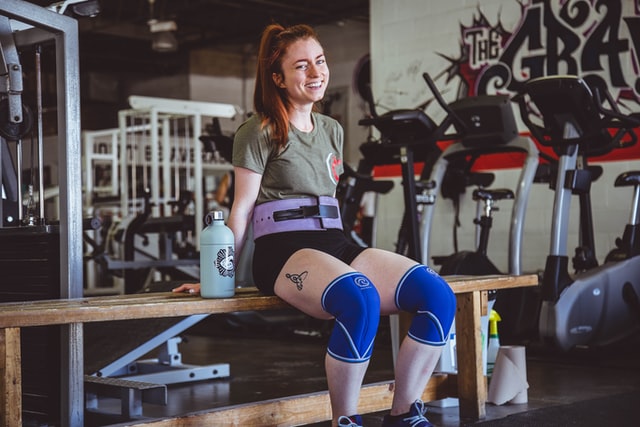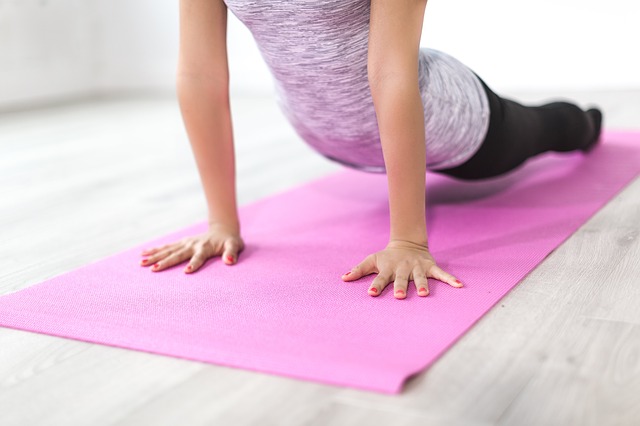I am often asked how to exercise with a bulging disc by my clients, who are usually active individuals. One of the worst things about a bulging disc is how it can stop you from doing the things you love. Returning to your usual exercise after a bulging disc can be a minefield; here’s a handy guide to getting it right!
Aims of this post:
- To give you a list of things to think about when it comes to exercise with a bulging disc
- To give you a checklist to tick off before returning to exercise with a bulging disc
- To give my own advice about when I would recommend someone returns to exercise with a bulging disc
- To detail the step-by-step method of how to do get back to full fitness
If you’re not looking to return to exercise with a bulging disc but would like some specific exercises to help with pain relief instead, go here.
Before we dive in, please be aware that we are part of the Amazon Affiliate programme. This page may contain Amazon affiliate links, so if you choose to purchase a product for your sciatica that we recommend through a link on this page, we will receive a small commission at no extra cost to you. This helps us keep Overcome Sciatica alive! Thank you for your support. Please be assured that we only ever recommend products that we truly believe can help.
A bulging disc is actually quite common in both athletes and people that take part in exercise for fun (Dunn 2006).
In fact, you might find a bulging disc in active people MORE than you do in the sedentary population. This is because of the risk of trauma in certain forms of exercise, which can make a disc bulge more likely.
One thing that a lot of my clients struggle with is knowing when it’s OK to go back to the exercise that they enjoy.
Maybe it’s squash that you’re missing out on? Maybe it’s running, or maybe it’s your Saturday morning game of bowls?
I have treated footballers with a bulging disc before too, so I know just how frustrating it can be to be told you need to wait ANOTHER few weeks before you can even think about getting back out there.
Because of the frustration of waiting around, missing out on your favourite hobby, it can be very tempting to rush things and go back to exercise too early.
Going back to exercise too early can be dangerous – and that applies for both recovery from surgery and conservative recovery.
This post will hopefully clear some things up when it comes to how to exercise with a bulging disc, as well as giving some general “rules of thumb” that you can follow, no matter what your sport or hobby is!
Things to consider when thinking about exercise with a bulging disc
While it would be absolutely ideal if we could get everyone back to exercise no matter what their injury, unfortunately it isn’t always logistically or sensibly possible.
I had a 30-year-old client before who loved extreme long-boarding.
He fell from his board one day, landing on his tailbone and causing a massive disc bulge at L5/S1.
It gave him terrible sciatica and numbness in both legs.
After opting for conservative management rather than surgery, we managed to get him 90% better in 4 months of diligent work, following exercise plans to the letter.
However, when it came to getting back on the board again, he just couldn’t do it.
Why?
It just wasn’t worth the risk.
He knew the hard work it had taken him to get better this time around and he was absolutely adamant he didn’t want to have surgery.
Although he loved his long-boarding more than anything, he was still young and he knew that one mistake could possibly lead to permanent damage on the next fall.
So he gave it up.
It’s not all doom and gloom though… he took up abseiling instead, to satisfy his need for an adrenaline rush from time to time (while keeping his back safe!)
Questions to ask yourself BEFORE exercising with a bulging disc
After a significant back injury, it’s important to really consider the following questions before you fixate blindly upon getting back to where you once were with your hobby:
- Do you want to still play the sport, even though it might have caused your injury?
- Can you realistically return to your pre-injury sporting level?
- What does your doctor, physical therapist, or other health care provider say?
- Have you done exercises to make sure your back is strong again (after you lost a lot of strength following the injury)?
- Are you still in good general health and fitness?
- Are you pain-free when you do the movements your sport requires?
- Have you regained all or most of the range of motion in your back and leg?
If the answer to one or more of these questions is “no”, it might be too early to consider that form of exercise yet.
Remember, there are alternatives out there to replace the void left behind by that type of exercise, and no sport or past-time is worth risking your independence and mobility.
Getting back to exercise after a bulging disc
If you answered “yes” to all the questions above, let’s talk about how you’re going to go about getting yourself back to your favourite exercise with a bulging disc.
First, we need to think about the type of exercise you want to get back to.
How strenuous is it?
What movements are involved?
Does it involve contact with another person (like football or rugby) or not (like golf or tennis)?
It’s really important that you make a list of the types of movements in your sport that you will need to do, should you go back to it.
For example, if your sport is golf, you would make a note of the following:
- Walking
- Long drive
- Chip
- Putt
- Full bend to pick ball up…
You get the idea!
Try making a bullet point list for your own sport or hobby.
The next thing to do is to circle any of those tasks within your activity that make you feel uneasy.
For example, when I treat clients who want to get back to golf, it is usually the rotation involved in a long drive that scares them most.
They fear that their back won’t be strong enough to carry out this action safely, and they may suffer a re-injury. They also often worry about spending 3+ hours on their feet at once, which is another important thing to consider with a bulging disc.
Once you have your list, set it to one side and save it for your first practice session.
First, though, we need to talk about when it is actually OK to start practicing again.
When is it OK to return to exercise with a bulging disc?
There is no universally accepted time-frame for when it’s OK to return to exercise with a bulging disc.
However, there are some studies that looked at the average time it took for athletes to get back to sport after a symptomatic disc bulge.
Iwamoto et al., (2011) stated that it took the athletes in their clinic on average 4.8 months to return to sport after their initial disc injury.
The same researchers stated that 79% of athletes successfully returned to their chosen sport within the study’s time frame.
These authors also concluded that the athlete’s symptoms had to be at least 80% better before they started any sort of sport specific come-back.
The participants in this study were both conservative management cases and surgical cases. The success rate for both groups was similar.
My advice for returning to exercise with a bulging disc
I feel that a few extra criteria should be met before someone returns to exercise with a bulging disc, along with the 80% symptomatic improvement rule.
- You should have mild pain at MOST when returning to sport. If your pain goes above a 3/10 intensity I would recommend stopping immediately and only resuming once pain levels are able to calm down and stay low throughout a training session.
- You should have a 90% full range of spinal motion and flexibility in the problematic leg. Returning to exercise before you’ve achieved this is asking for trouble.
- Your strength levels should feel normal again. If they don’t, you need to work on strengthening your back and legs with exercises at home before you consider returning to exercise with a bulging disc.
- If your sport involves cardiovascular endurance, you need to make sure your fitness is 80% of normal before you return to exercise. When we get tired, our movements become sloppy and injury becomes more likely, so going back to sport before your fitness is at an acceptable level is asking for trouble.
- You should also not have any symptoms like persistent numbness, lower limb weakness or bladder and bowel problems before considering exercise.
This list isn’t exhaustive! You need to take into account exactly what it is your activity requires from you; the demands of a rugby player are going to be different from that of a darts player!!
How to return to exercise with a bulging disc
You should, in all cases, follow what we call a “graduated return to play” programme.
This means that you gradually introduce the activity again, rather than diving straight in.
This involves a few components that should all be checked off:
- You need to regain a full range of motion at your spine. Do this by performing spinal range of motion exercises until you can bend, extend and rotate just as you could prior to your injury.
To learn what NOT to do when regaining your spinal mobility, click HERE!
- You need to regain strength in your back and legs. After any injury, we rapidly lose strength. It is important to slowly build this strength back up again through exercises at home or in the gym.
You also need to improve your flexibility – for my guide on how to do this, click HERE!
- You need to practice the specific movement patterns your sport demands. For example, if my sport was golf, I would practice the swing motion without a club at home, trying to perform it with the best technique I could before I actually swung for a ball.
- You need to make sure your fitness is up to scratch, by finding a type of cardiovascular training method that doesn’t aggravate your pain (e.g. cross-trainer, stationary bike).
- You need to GRADUALLY re-introduce the sport after you have checked all the above off. This will involve probably playing/training for one quarter of what you used to do first. If you play a team sport, a substitute appearance for the last 10 minutes is ideal. If you are a cyclist, try one quarter of the distance you normally go. If you play golf, try playing 2 holes only then calling it a day.
- Bit-by-bit, build it back up. If at any point you feel your symptoms worsen, you need to take one step back the next time you try your activity, then try to build up again the following week.
NB: Because this is such a detailed topic, I can only go into so much detail within this post. If you would like more detail on the steps above, you should check out my book! It walks you through this method step-by-step with detailed pictures and instructions, with the aim of getting you back to your chosen activity as soon as possible!
Returning to Cardiovascular Exercise with a bulging disc
Rather than returning to any specific sports, many of my clients want to return to general cardiovascular exercise with a bulging disc. This includes exercise like running, cycling, walking and swimming.
Let’s talk about each type of exercise in turn and discuss the considerations around each of these types of exercise with a bulging disc:
- Walking: Walking is generally very good for people with a bulging disc and can help problems like disc bulges and prolapses to heal more quickly. However, those with a condition called spinal stenosis should be aware that walking is often a trigger for their symptoms. Here are the considerations someone with spinal stenosis should take into account.
- Running: While running is not a “harmful” exercise for most people, those who have disc bulges or prolapses might find that running makes their pain worse. This is because of the impact our bodies absorb when we strike the ground as we run. I usually tell people to avoid running when they have sciatica until the pain is truly settled. As an alternative, try the cross-trainer instead.
- Cycling: Cycling is a good exercise for many injuries, but it will aggravate sciatica caused by disc problems or sciatica caused by piriformis syndrome. For this reason, cycling is best avoided when sciatica is still present. As an alternative, try the cross-trainer, walking or swimming. Cycling is usually fine for people who have spinal stenosis.
- Swimming: Swimming is one of the safest forms of exercise for most injuries because being in the water instantly removes 50% of your body weight in a functional sense. Try a variety of strokes, avoiding any which are painful, and combine that with walking in the pool which builds strength. I recommend swimming 1-3 times a week for most of my clients as an alternative type of exercise with a bulging disc.
Returning to Strength Training Exercise with a bulging disc
Strengthening exercise with a bulging disc is fundamentally important to improve overall health and return to full fitness.
Many of my clients report being afraid of getting back into the gym with a bulging disc. For most people, the gym is NOT somewhere to avoid when you have a bulging disc – instead, just be careful with which exercises you choose.
For a start, avoid anything that is painful at the time.
Some exercises such as the squat and the deadlift, are likely to be painful for people with have disc bulges or prolapses. These can be replaced temporarily by exercises that are more isolated and involve smaller movements, such as the weight machines and the bench press.
One should also be careful on the leg press machine, as this can increase the pressure on the discs in the spine.
If you feel anxious about returning to weight training exercise with a bulging disc, a weight training belt is something that can be considered. You can read my top recommendations for the best weight training belts for sciatica here.
What about Yoga and Pilates Exercise with a bulging disc?
Another popular type of exercise that CAN help a bulging disc is Yoga and Pilates.
Yoga involves stretching and mobility exercises, while Pilates involves mobility and strengthening exercises, generally speaking.
Both of these types of exercise are good for most people with a bulging disc, but there are some considerations to make.
Firstly, Yoga often involves a lot of stretching, which can be painful for those with a bulging disc. Only perform the exercises in the class that you can manage without pain. Not all stretches are good for sciatica, as discussed here.
Secondly, Pilates is often better tolerated by people with a bulging disc – but again, it is important to avoid the exercises in the class that are painful.
Generally, these types of exercise for a bulging disc are a good place to begin for most people who want to build up their core strength, balance and mobility.
Summary
I hope this post has shed some light on exactly when you should be considering a return to sport after a bulging disc, as well as a few ideas on how to go about getting back into your chosen activity.
If you have any questions or comments about this post, why not leave me a comment below? I try to get back to every single one.
Seriously, don’t be shy!
I hope you have enjoyed this post and I look forward to speaking to you soon.
If you would like some more help in recovering from a bulging disc, check out my recommended treatment programme below:
Are You Looking for RAPID Relief from Sciatica?
My good friend, colleague and fellow international sciatica expert, Dean Volk, has a brand new sciatica relief video course available – and I’m delighted to be an official sponsor!
Check out Dean Volk’s “Kicking Sciatica OUT of the Butt!” Online Pain Relief Course Here!
I can proudly recommend Dean and his course for sciatica sufferers – because I’ve seen his incredible results first-hand. You can check out his course (and get lifetime access to the videos and bonus content) by clicking HERE.
The information on Overcome Sciatica should never be used as a substitute for medical advice from a doctor. Never put into action any tips or techniques from Overcome Sciatica without checking with your doctor first. Please see full terms of use here.











